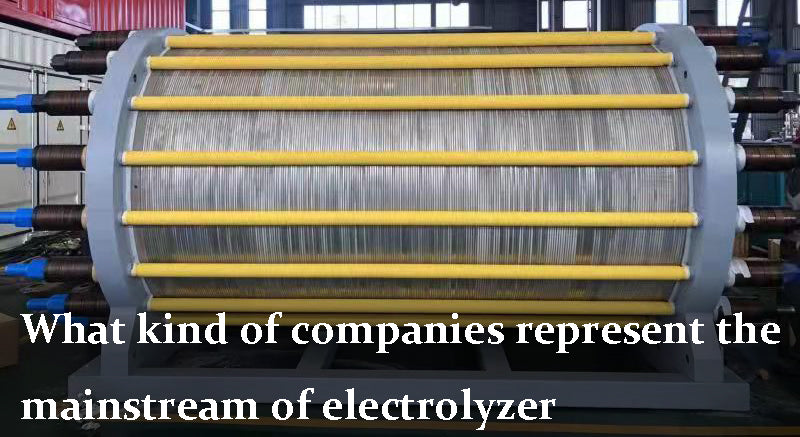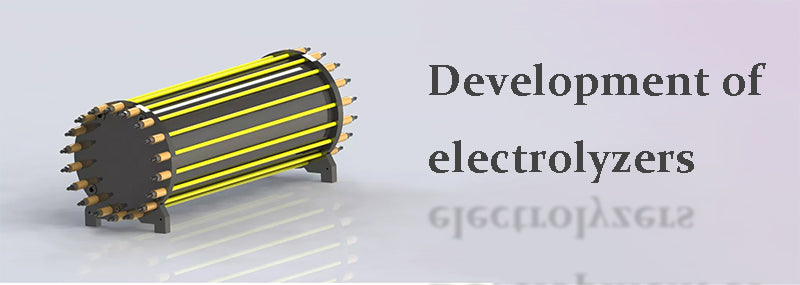Main content:
Worldwide, the 500 hydrogen projects announced in 2021 equates to a potential direct investment of $160 billion, a 100% increase compared to 2020. A total of around 250GW of electrolysis projects in the world are expected to be built over the next decade. Under such expectations, the production capacity of the world electrolyzer industry has expanded rapidly. In the short term, the number of Chinese manufacturers has increased by 10-15 times, and the production capacity plan has increased by about 20 times.
Which electrolytic cell is more promising
Some time ago, there was a debate about lithium batteries and hydrogen batteries. Lithium batteries obviously have the upper hand, but hydrogen has more advantages in terms of environmental protection and resources. Hydrogen as an energy source is not only used in fuel cells for automobiles, but also has a wider application space than lithium batteries as energy storage.
Even in the field of transportation, fuel cells can make up for the shortcomings of insufficient energy density and poor low-temperature performance of lithium batteries, and have more advantages in the fields of commercial vehicles, ships, and rail transit. Next is the debate about the source of hydrogen, grey hydrogen, blue hydrogen, green hydrogen? Or hydrogen production from fossil energy, industrial by-product hydrogen, or hydrogen production from green electricity?
We need to make comparisons from various dimensions such as technology maturity, access convenience, hydrogen production cost, and environmental protection. At present, it is generally believed that green hydrogen, that is, hydrogen production from renewable energy, is the mainstream direction of hydrogen energy development, and other hydrogen production methods are supplemented.
Renewable energy hydrogen production and industrial by-product hydrogen are the most mainstream methods at present, but fossil energy hydrogen production has been opposed. However, hydrogen fuel cells are developed rapidly in China and here is a top 10 hydrogen fuel cell companies in China article for you.
There are also some disputes on the storage and transportation of hydrogen. Different hydrogen sources, transportation volumes, and transportation distances should choose different methods. High-pressure hydrogen storage, solid-state hydrogen storage, liquid hydrogen storage, pipeline transportation, or organic liquid hydrogen storage have their own advantages. application scenarios. The development of hydrogen energy will become an important means to achieve the goal of carbon neutrality and energy security.

Hydrogen production from renewable energy is the main source of hydrogen energy, and a variety of hydrogen storage methods are available. In short, electrolyzers will usher in huge development opportunities. Today, many countries rely on PEM, and China is dominated by alkali tanks. More people think that PEM can better represent the future. Alkaline electrolyzers appear to be increasing this year, while PEMs appear to be decreasing.
More importantly, all 52 electrolyzers in the Kuqa project in Xinjiang, China's influential project, all use the alkaline technology route. Moreover, there are about 150 companies entering the electrolyzer in China recently, and more than 100 of them are in the direction of alkaline electrolysis.
The electrolyzer development is not mature
Electrolyzer is not a new industry, it is a technology with more than 200 years of history, alkaline electrolyzer has been industrialized for nearly a hundred years. The development of alkaline electrolyzers has mainly experienced from normal pressure to pressurization, from asbestos diaphragms to non-asbestos diaphragms, and from small scale to large-scale. At present, megawatt products with pressurized non-asbestos diaphragms have become the mainstream products of alkaline electrolyzers.
A single electrolyzer can already achieve 1300Nm3/h. In contrast, PEM electrolyzers are still in the early stages of industrialization. It is a technical route derived from fuel cell technology. In 1996, Proton OnSite in the United States began to develop and manufacture PEM electrolyzers in cooperation with United Technologies Aerospace Systems. After that, PEM electrolyzers began to explore industrialization.
In 2014, the European Union proposed the development goal of PEM water electrolysis hydrogen production technology: the first step is to develop a distributed PEM water electrolysis system for large-scale hydrogen refueling stations to meet the hydrogen demand for transportation. The second step is to produce 10, 100, and 250 MW PEM electrolyzers to meet industrial hydrogen demand.

At present, the single-cell scale of China's leading alkaline electrolyzers in the world is 1-6.5MW (China's leading product is 5MW), while PEM The single-cell size of the electrolyzer is 0.25-2.5MW (the leading product in other countries is 2.5MW). By 2018, the world's total electrolyzer shipments were only 135MW, equivalent to 27 1000Nm3/h electrolyzers. According to statistics, by 2014, the cumulative shipment of alkaline electrolyzers in the world was 19.84GW, and by 2017, the cumulative shipment was about 20GW.
According to statistics, it is expected that another 3.81GW will be shipped from 2018 to 2023, and the cumulative shipment will be 23.81GW by 2023. By 2017, the cumulative shipments of PEM electrolyzers in the world were about 30MW, and the shipments are expected to be 1.31GW during 2018-2023, with a total of 1.34GW in 2023. The electrolyzer is mainly a stable power source to produce hydrogen, and more hydrogen is used in essential industrial principles or reducing agents.
These experiences are not enough to solve the problem of renewable energy, and the development of the industry faces technical difficulties. In the face of new application conditions, traditional electrolyzer technology still needs to be improved. Although world electrolyzer shipments will total 458MW by 2021, representing a CAGR of 50% compared to 2018, there is not enough data in these projects to verify the efficiency and efficiency of the actual operation of alkaline electrolyzers and PEM electrolyzers.
What kind of companies represent the mainstream of electrolyzer
Electrolysis is the process of electrolysis. When direct current passes through the electrolytic cell, an oxidation reaction occurs at the interface between the anode and the solution, and a reduction reaction occurs at the interface between the cathode and the solution to generate hydrogen and oxygen. At present, alkaline and PEM are the only two types of electrolyzers in the world that have been industrialized, and they use different catalysts, electrolytes and structures.

The electrolyte is a conductive medium containing ions, and the alkaline cell electrolyte is an alkaline solution containing 30% potassium hydroxide. Also, alkaline battery is quite different from lithium battery and we can distinguish them by reading lithium vs alkaline batteries article. In PEM electrolysis, the electrolyte is a proton exchange membrane made of a solid polymer. Alkaline electrode materials mainly include nickel or nickel-aluminum alloy coated steel, and alkaline electrolysis is performed in an alkaline electrolyte.
PEM cells use iridium or platinum coated steel/titanium for PEM electrolysis in an acidic environment. The PEM electrolyzer is the reverse reaction with the fuel cell. In the 1960s, fuel cells began to be used in spacecraft. In 1962, DuPont improved the proton membrane, and on this basis, it launched a civilian hydrogen generator in the 1980s. That is to say, the appearance of alkaline electrolyzers was initially based on the electrolysis of water to produce oxygen, and then applied in industrial hydrogen.
The background of the emergence of PEM electrolyzers is based on the background of hydrogen as power, and its research focuses on indicators such as energy utilization, adaptability to fluctuations in renewable energy, and hydrogen output pressure of electrolyzers. But in reality, alkaline electrolyzers are already on a large scale, and have undergone many upgrades in output pressure, electrolyzer power, diaphragm materials, etc. to improve efficiency and adaptability to the working environment, while PEM is still in performance and service life.
Validated and improved stage. So, in terms of the maturity of turning water into hydrogen, alkaline electrolyzers are very mature, and PEM is still in the growth stage. But in terms of working principle, PEM electrolyzer is more suitable for the unstable working state of renewable energy. At present, the world's major electrolyzer manufacturers are located in Europe, the United States and China.
Among them, European and American countries are mainly PEM, and representative companies include Siemens, Cummins, ITW Power, NEL, and Prager. While China is mainly alkaline, representative companies include Cockrell Jingli, Perry Hydrogen Energy, Tianjin Continental, LONGi Green Energy and so on.

Development of electrolyzers
China has an absolute advantage in the cost of alkaline electrolysis cells. The price of alkaline electrolysis systems is generally only 25% of the same type of projects in Europe and the United States. The cost of PEM electrolysis systems is about 15% higher than that of alkaline electrolysis systems in Europe and America.
By 2021, the cost of a 10MW alkaline electrolysis system in China may be about $300/kW, and the cost of PEM in China is about 4-5 times that of an alkaline electrolyzer. The same system in Europe and the United States is at least $1,200/kW, and the PEM electrolyzer is about $1,400/kW. However, because China's alkaline electrolyzers are relatively mature, and it is difficult for more and more large-scale electrolyzers to achieve automated assembly line operations, PEM electrolyzers are accompanied by technological progress and large-scale production.
The gap has narrowed considerably. Judging from the shipments of electrolyzer manufacturers, the single-cell power of alkaline electrolyzers (Cocklier Jingli) has reached 6.5MW, the mainstream products are 2.5-5MW, the single-cell power of PEM electrolyzers is up to 2.5MW, and the mainstream products 0.73 -2.5MW. Under normal circumstances, the efficiency of alkaline electrolyzers is 70%, and the efficiency of PEM is 80-85%.
Outlook for electrolyzers
Although the cost of alkaline electrolyzers is lower than that of PEM electrolyzers, the proportion of electrolyzers in the total renewable energy hydrogen production is still not high. But considering the efficiency of the whole life cycle of the electrolyzer, the same life cycle and the same capital investment, the output of PEM is 30% more than that of the alkaline electrolyzer.
Related article: lithium ion battery electrolyte, top 5 battery electrolyte companies, hydrogen energy storage
















